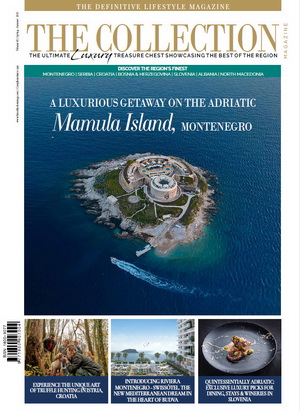Palace Elisabeth – A Timeless Landmark Of Luxury And Elegance On Hvar
This heritage hotel, situated in the very heart of Hvar, above the city hall and the marina, is a proud member of Leading Hotels of the World as well as of Virtuoso’s exclusive network of preferred partners. These memberships are a testimony of the hotel’s ongoing commitment to excellence, delivering exceptional experiences to all who visit.
The hotel was built in place of the residential complex of the Duke’s Palace on the main town square, the largest square in Dalmatia. The palace was at its height during the rule of Venice, but after the fall of Venice it lost its spark, became neglected and was eventually demolished at the turn of the 19th century. In 1899, the palace was rebuilt and named Spa Hotel Empress Elisabeth in honour of the renowned Austrian Empress Sisi, a generous patron of its construction. Today, the property is known as Palace Elisabeth, respecting its rich history and tradition.
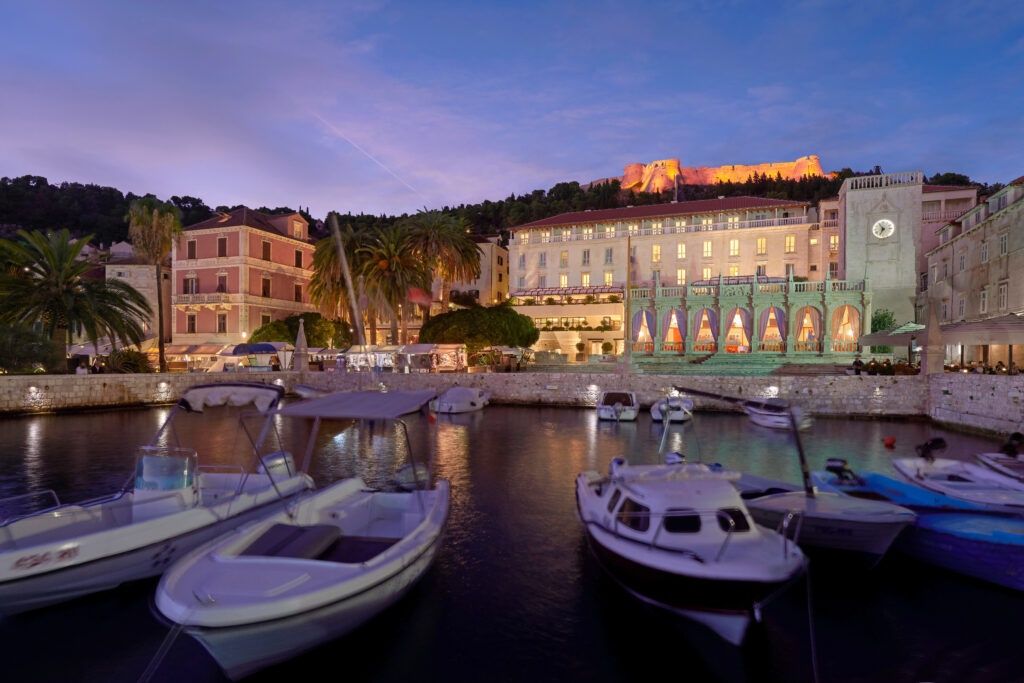
EXCEPTIONAL SERVICE AND LUXURIOUS ACCOMMODATIONS
The hotel features stunning Venetian and Austrian architectural details. Guests at Palace Elisabeth can indulge in one of 33 luxurious rooms and 11 suites with unique designs and exquisite details. The hotel’s commitment to great service is evident in every aspect of the guest experience, from the meticulous turn-down service to the convenient luggage transport from the Port of Hvar or private airport transfers.
Palace Elisabeth offers a range of top-tier amenities that enhance the guest experience, which include an indoor swimming pool, terraces with unparalleled views of the town and harbour, a wedding chapel and a gym located below one of the largest private wells from the Venetian era, decorated with statues of winged lions with a book and a figure of St. Stephen, pope and martyr, patron saint of the town of Hvar. Palace Elisabeth’s anti-aging spa, inspired by Empress Sisi’s devotion to health and beauty, celebrates her legacy by offering a blend of traditional elegance and modern sophistication, ensuring each guest experiences the transformative power of self-care, just as Empress Sisi did.
Palace Elisabeth is also renowned for San Marco restaurant, positioned on top of the famous Loggia, overlooking the main town square. The restaurant is a haven for those who want to enjoy delectable dishes with uninterrupted sea views and taste Mediterranean cuisine with innovative and artfully-presented dishes inspired by fresh, local products and aromas that together create a truly unique culinary experience.
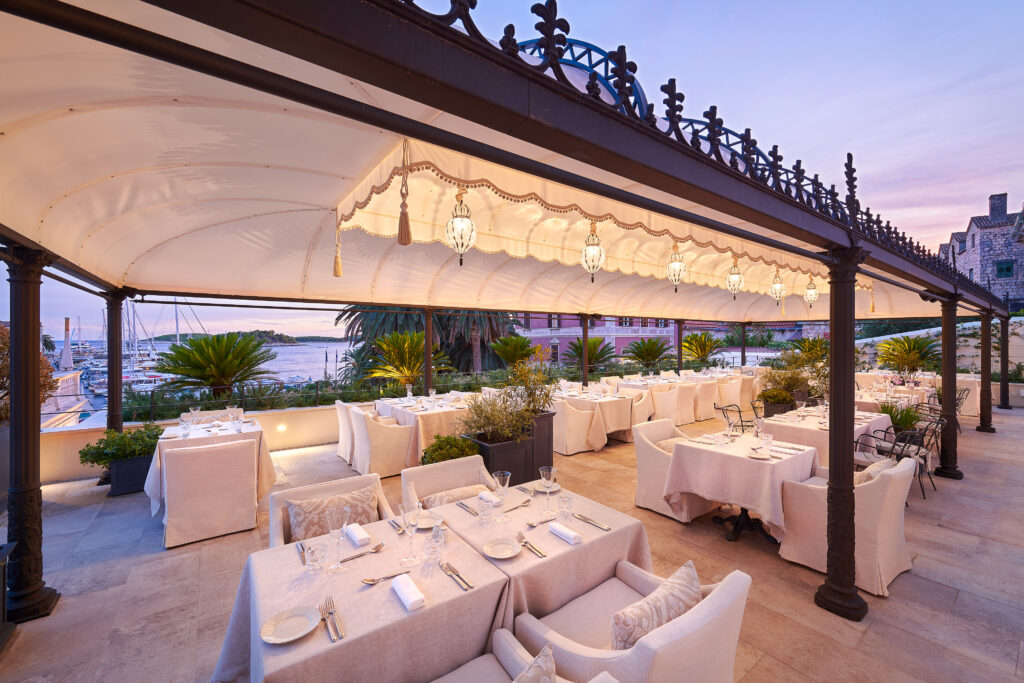
THE HERITAGE
The entrance to Palace Elisabeth is through an archaeological site – the former southwestern part of the old city wall with cannon holes throughout, since Hvar has long been an important maritime hub and a safe harbour for ships that needed protection. The excavations have confirmed that back in the ancient times, before the Venetian rule, there was also a villa or a residential building in this very place, which probably belonged to a ruler.
To the left of the entrance is a small Mediterranean garden with wild orange trees, planted at the very spot where centuries-old orange seeds were found. There, you can see stairs dating back to the 2nd or 3rd century, that probably served as a formal entrance to a monumental building.
Two stone lions, placed at the entrance of the hotel, symbolise the Venetian authority and date back to the mid-15th century. The larger lion is the oldest preserved stone lion in Hvar. It was placed on the upper Duke’s palace in 1462 by Francesco Giusti, the Duke of Hvar at the time. The smaller lion, made in 1483, was positioned on the lower Duke’s palace. An unknown stonemason exceptionally displayed the symbol of the Venetian rule with veins on his legs and human features. His front paws were placed on land and his back paws were placed in the sea, symbolically displaying the might of the Venetian Republic both on land and at sea – Stato da Terra and Stato da Mar.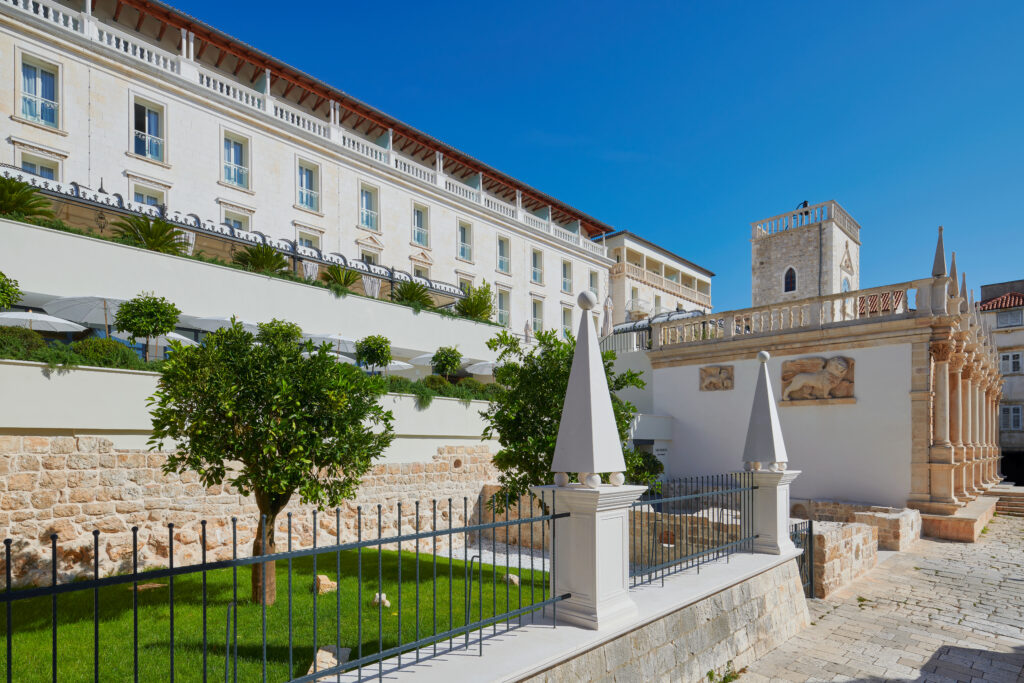 At the spa and gym entrance there is a dark stone panel, which is the lintel of the Chapel of the Lady of Sorrows, once located in the central building of the Duke’s Palace. The chapel was built by Duke Pietro Semitecolo, founder of the Hvar Teatre, the first theatre in Europe.
At the spa and gym entrance there is a dark stone panel, which is the lintel of the Chapel of the Lady of Sorrows, once located in the central building of the Duke’s Palace. The chapel was built by Duke Pietro Semitecolo, founder of the Hvar Teatre, the first theatre in Europe.
The Hvar Loggia – a town hall and a centre of secular power, was first mentioned in 1289. Throughout its history, it served as a public courtroom, auction space, a warehouse and a kursalon – a place for citizens to gather and socialize.
Today, the Loggia attracts attention with its harmonious arches and warm stone colour, with human heads carved at the top. On the very eastern arch, a young man with no wrinkles is portrayed, as a symbol of the beginning of life and youth. Above the entrance, there is a figure of a bearded man with a crown, as a symbol of the solar zenith, and on the very western arch of the Loggia is the figure of a bearded, old man with a hat, as a symbol of departure, sunset, and the near end of life.
The clock tower, which became the city’s public clock in the 15th century, is adjacent to the Loggia and in Hvar it is known by the local name Leroj (clock).Church of St. Cosmas and Damian, now used for weddings and baptisms, is located east of the hotel building and is the oldest preserved church in Hvar, built around 1430, after a series of plague epidemics that ravaged Hvar. It is dedicated to the brothers Cosmas and Damian, doctors, protectors from all evil.
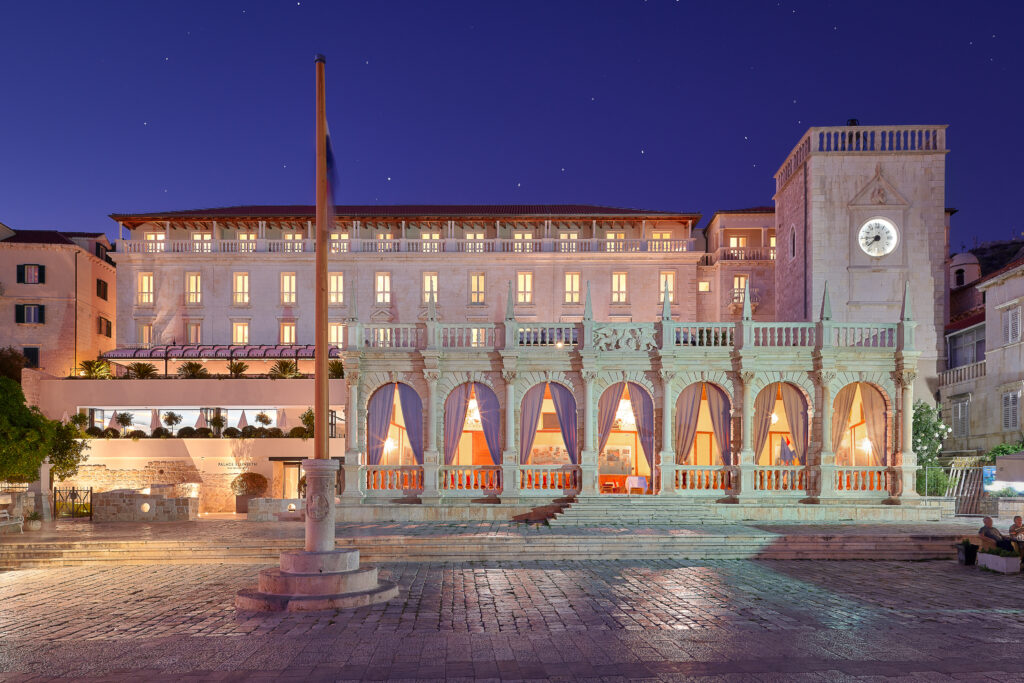 Visit Palace Elisabeth to experience the grandeur and luxury at a place where history, elegance, and exceptional service converge to create an unforgettable stay.
Visit Palace Elisabeth to experience the grandeur and luxury at a place where history, elegance, and exceptional service converge to create an unforgettable stay.
CONTACT US!
- A: Sunčani Hvar d.d., Ive Miličića 3, 21450 Hvar, Croatia
- W:www.suncanihvar.com/palace-elisabeth-hvar-heritage-hotel
- T:+385 21 750 400



